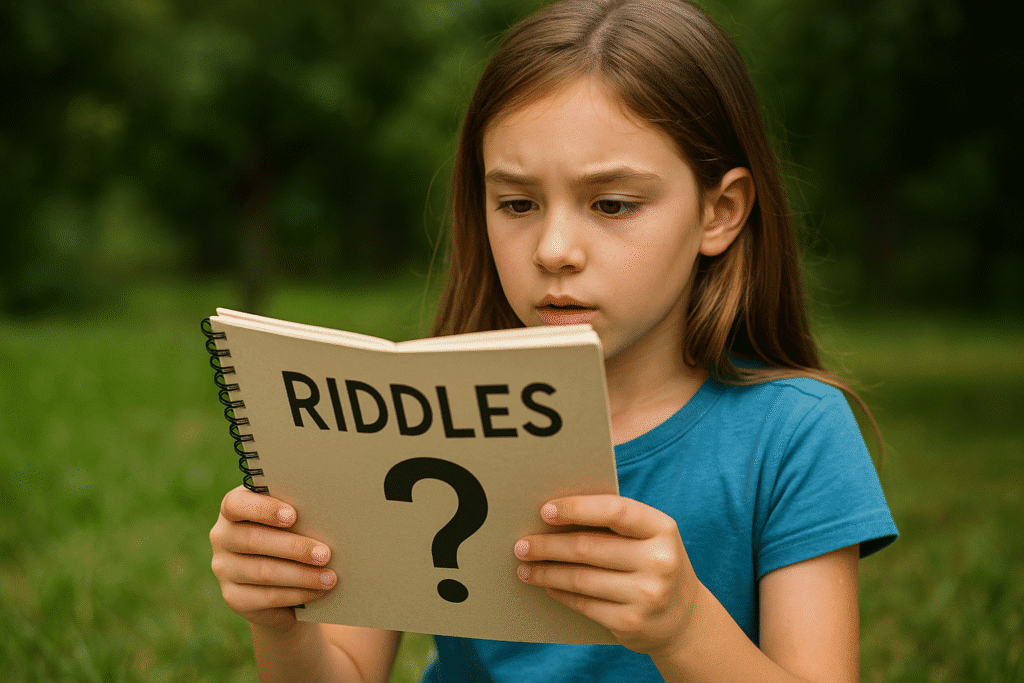How Riddles Boost Children’s Brainpower, Backed by Science

Why Riddles and Puzzles Are Powerful Tools for Growing Minds
If you’re a parent or teacher of children aged 8 and up, you may already know that riddles are fun, but research shows they’re also powerful tools for boosting problem-solving, creativity, and academic performance. In fact, the benefits begin even earlier. From toddlers handling jigsaws to middle schoolers decoding riddles, puzzles can sharpen thinking and stretch imaginations at every age. In this article, we’ll explore how riddles for children support cognitive development, learning, and memory across age groups.
Early Benefits: Toddlers to Age 7
One of the earliest studies on puzzle play comes from a longitudinal study of 2- to 4-year-olds, which found that children who regularly engaged in puzzles developed stronger spatial transformation skills by age 4.5. Quality of parent involvement (e.g. using spatial language, words like ‘above’, ‘next to’, ‘under’, or ‘through’ that describe how objects relate in space, and encouraging perseverance) was a key factor. Notably, girls whose parents used more spatial language showed particularly strong outcomes.
In a separate preschool study, researchers observed that long-term engagement with riddles, presented verbally and visually, boosted key cognitive skills including comparison, classification, generalisation, and systematisation. Even at this young age, riddles were shown to lay foundations for analytical thinking.
For children aged 5–6, puzzle-based activities such as jigsaws significantly improved visual-motor coordination, pattern recognition, and shape memory. These benefits translated into stronger early learning outcomes across literacy and numeracy.
Why Riddles Start to Click at Age 8
From age 8, children’s ability to understand and enjoy riddles takes a leap forward. A 1982 study found that around this age, children reliably comprehend and appreciate riddles. Researchers linked this to vocabulary development and the ability to think in more abstract terms. Children who could explain the double meanings in riddles were more likely to laugh and smile, indicating both cognitive and emotional engagement.
Linking Riddles to Brainpower
Research published in the Psychology of Language and Communication found that children’s performance on folk riddles correlated strongly with standard intelligence test scores. A 2023 study further supported this by quantifying the effect: for each correct riddle answered, IQ was an average of 1.6 points higher, suggesting riddles can offer a quick insight into a child’s reasoning capacity. This highlights the value of riddles for learning and intellectual growth.
Supercharging Creativity Through Wordplay
Other studies have looked at more modern formats. A 2021 study introduced audiovisual riddles to 8–12-year-olds and found significant improvements in creativity scores, especially in originality and fluency. These findings suggest that riddles can stimulate divergent thinking, making them ideal for creative classrooms and at-home enrichment. For parents and teachers, riddles for children are an engaging way to promote flexible thinking.
Why Humour Signals Deep Learning
The same 1982 study that linked riddle understanding to vocabulary also found that genuine laughter in relation to riddle solving around age 8 marks real cognitive engagement, not just surface amusement. Among children aged 8–11, over 70% of those who successfully explained the riddle also laughed or smiled. In contrast, only 3.5% of 4– to 5-year-olds were able to explain riddles correctly, suggesting more limited comprehension at that stage (the study does not clarify whether the younger children laughed or smiled when they reached the solution).
Making Maths and Logic Even More Fun
Puzzles also play a growing role in STEM learning. A classroom study integrating puzzles into maths lessons for children aged 7–12 showed improved logical reasoning, abstraction, and memory. Teachers reported higher levels of classroom engagement and problem-solving confidence.
A separate 2021 study focusing on logic-based games like Lightbot found that children developed distinct strategies when solving visual puzzles. These included step-by-step testing ( i.e. vary one thing at a time) and pattern recognition through iteration. These methods mirror scientific problem-solving techniques, suggesting the potential for long-term transfer into other learning domains and topics.
Reaching Every Learner, Everywhere
Research from Indonesia with school-aged children found that puzzle-based cognitive stimulation improved academic outcomes across a wide range of learners, including those facing physical development challenges. The findings highlight the adaptability of puzzles and riddles as effective, low-cost learning tools regardless of setting.
Brain development studies also show that executive function – the mental skill set that helps with focus, planning, and self-regulation – accelerates from age 8. These functions underpin the ability to persist with a tricky riddle or tackle a complex logic game, suggesting that this age is a turning point for deeper cognitive engagement.
Teen Brain Gains: Why Older Kids Still Need Puzzles
Teenagers experience a surge in executive function between the ages of 12 and 15, including sharper planning, better impulse control, and improved working memory. These skills align directly with the demands of solving complex riddles and logic puzzles, making adolescence a prime time to keep those brain circuits buzzing. Neuroscience reviews confirm that verbal working memory, planning and cognitive flexibility all improve significantly during this window.
Tower of Hanoi Reveals Strategic Growth Mindset
A 2022 functional MRI study tracking teens and young adults using the Tower of Hanoi puzzle showed improved planning and decision-making after just seven weeks of practice. Participants displayed reduced brain activation in executive regions over time, suggesting their brains were becoming more efficient at solving complex tasks. While not riddle-based, this puzzle supports long-term strategic thinking and mirrors how riddles encourage step-by-step reasoning.
Digital Puzzles Boost Focus and Self-Regulation
A study using low-cost digital word games with adolescents reported measurable improvements in self-regulation and persistence. These benefits were especially strong in students who initially struggled with executive functioning, offering a promising tool for inclusive learning. Again, while not specifically riddles, the findings reinforce the cognitive value of language-based puzzles and brain games for kids.
Creativity and Logic Still Matter in Secondary School
A 2017 educational review found that puzzle-solving in secondary school classrooms boosted motivation, scientific reasoning, and content retention. Students engaged more deeply in lessons that used structured problem-solving or lateral thinking activities, making puzzles a smart choice across subjects.
Psychology Today also highlights that word puzzles and brainteasers help teenagers strengthen executive function skills, such as attention control, planning, memory, and impulse management. While studies are still clarifying how this works, the benefits of practising these skills through puzzles are already widely recognised by educators and psychologists alike.
The Chamizer Method: Riddles in Action
Dan Chamizer is an Israeli artist, media personality, and educator who pioneered the use of riddles as a structured teaching method. He is best known for creating interactive national radio quizzes and classroom programmes that encourage associative and lateral thinking through daily riddle-solving challenges.
Chamizer’s riddle-based teaching approach, used widely in Israel since the early 2000s, has reached more than 500,000 students. His method encourages associative and lateral thinking through daily riddle challenges, aiming to build curiosity, creativity and initiative in learners across subject areas. This long-running success story reinforces the value of riddles for education.
Using Riddles in Child Psychology
In 2024, a letter to Academic Psychiatry raised the idea that riddles might have a role in child and adolescent psychiatry, perhaps by helping professionals think through diagnoses or by offering a way to connect with young people during counselling. Essentially modern academics might have stumbled on age-old wisdom: riddles do more than entertain. It’s early days, but it’s interesting to see if more theories in this area will be considered in clinical settings, to benefit children.
A Smart, Simple Way to Build Thinking Muscles
From improved memory and maths to boosted creativity and strategic reasoning, riddles and puzzles are far more than wordplay, they’re cognitive workouts. For teachers, they offer low-cost, high-reward classroom tools. For parents, they provide a fun way to stretch young minds at home or on the go. Best of all, they foster joyful learning, something every child deserves. Riddles for children are more than just fun – they’re one of the simplest ways to boost learning, literacy, and lifelong thinking skills.
If you’d like to find out more about reading with riddles for kids, visit the children’s books with riddles recommendations page.


